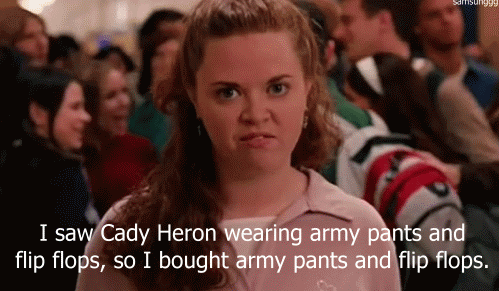“Fashion is instant language.”
-Miuccia Prada
We are currently living in the age of communication, and one of the fastest forms of communicating (which often goes unnoticed), is your clothes. We don’t even realize it, but everyday our fashion choices and person style send specific messages about ourselves. We wear certain styles because other people in our circles wear them, which is a rather peculiar notion when we take a moment to ponder it. Somebody in “the industry” sets a few trends for the season and we rush out to keep up with the times. Some of us follow fashion religiously and buy new styles before everybody else, while we discard the old just as quickly. Others follow fashion moderately, picking and choosing the pieces we like, often after they’re already “out.” Yet other people refuse to follow it entirely and conform to the counterculture, which is still technically a form of conforming (sorry, Hipsters).
What is the function of fashion?
Stop for a moment and assess the outfit you’re wearing right now. Your clothes and personal style speak volumes about you. Sometimes the way you look says more than the words you say, especially to those who don’t know you. A blazer and skirt makes a different statement than a worn-out pair of black jeans. Blonde hair with caramel highlights says something different than blonde hair with streaks of pink.
Every decision we make about our personal style speaks of our identity and informs those around us about the varied “tribes” we belong to. Some of us belong to the corporate tribe of business managers, while others fall in with free-spirited artists.
So, where did fashion come from?
Fashion originated in Europe in the 14th century by those who had disposable income and leisure. Spending time and money on one’s appearance and clothes showed that they were in the upper echelons of society, and had access to royalty. Queen Elizabeth I, for example, had an enormous wardrobe and would show off her gowns regularly, creating trends in the process. Those in her inner circles would know what was hot before the rest of the common people. So, basically, staying on top of fashion showed people that you were cool with the popular kids.

High heels, for example, originated in Europe in the 1600’s by male aristocrats. Not only does the extra height make the wearer appear taller (and therefor more powerful) it also shows that the wearer must have a job that requires little manual labor for them to wear such silly footwear. At this same time, women were going through a phase in history when they sought to dress like men (for power). Women began to imitate men’s fashion, which lower classes then pursued. However, as women and lower classes adapted to heels, the rich, male (and dare I say, snobby) nobles withdrew from the style because they did not want to be associated with women and plebeians. In turn, the fashion grew and was adapted with each season, until it reached your very own feet.
Well, where do we fit in?
There’s two theories out about how fashion is integrated in out daily lives. The trickle-down effect explains how styles originate with designers and celebrities, before they slowly make their way down to us “commoners,” as explained flawlessly by Miranda Priestly (Meryl Streep) in The Devil Wears Prada:
The other origin of trends is that they emerge from the streets, like “urban grunge,” or “punk.” Take the trend of sagging pants, for example. While the exact origins of this look are unknown, it’s been said that it originated in California prisons in the 1980’s. Male prisoners were given uniforms, but not belts, causing their pants to sag. When they went back to life outside of jail, many brought this style with them because that’s what they were used to.
So, if you wear saggy pants, you’ve been influenced by prison style and and you’re telling the world which “crew” you belong to. Grant it, over time, styles evolve, grow, and take on different meanings (you’d never call somebody masculine today for wearing high heels, but that was not the case 400 years ago).
The next time you see a style that you absolutely need to have, consider for a moment what the trend says about you, what your buying habits say about you, and what the fashion industry says about society. The roots of fashion are based in excess and waste, and those roots have continued to trickle down to current times.
[Featured Image Credit:yunguyen666 via Flickr]
